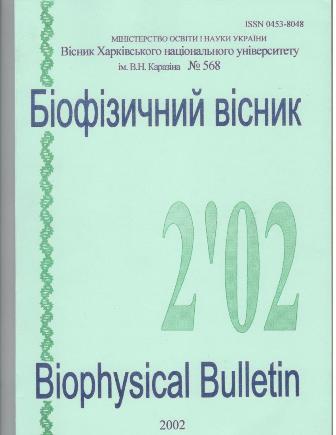Effect of side groups of phenanthridines on their hetero¬association with antibiotic daunomycin and the competitive binding with a DNA oligomer.
Abstract
500 MHz 'H NMR spectroscopy has been used to study the hetero-association of phenanthndine dyes, containing different side groups in the chromophore, with anthracycline antibiotic daunomycin (DAU) and the competitive binding of aromatic dye/drug molecules with a DNA oligomer 5'-d(TpGpCpA ). The magnitudes of the hetero- association parameters of Ethidium Bromide (EB) and its azido-denvatives, 8-azido-Ethidium Bromide (EMB) and 3,8-Diazido-Ethidium Chloride (EDC) with DAU show a successive decrease with mono and di-substitution ot the 3,8-amino groups of EB due to less probability of the formation of an intermolecular hydrogen bond between the amino groups of EB and the 9 MeCO group of DAU. Analysis has shown that the equilibrium balance of self- association, hetero-association and dye/drug-DNA binding depends on solution conditions. In order to elucidate the molecular complexation processes in multi-component equilibria occurring in mixed solution (including mutagen, aromatic antibiotic and DNA), it is necessary to take into account not only the hetero-association of the aromatic molecules but also the competition between drug and mutagen for the oligonucleotide binding sitesю.
Downloads
References
Gale E.F., Cundliffe E, Reynolds P.E., Richmond M.H., Waring M.J. // The molecular basis London. 1981.500p.
Graves D.E., Velea L.M. // Current Org. Chem. 2000. V.4. P. 915-929.
Davies D.B., Veselkov D.A., Kodintsev V.V., Evstigneev M.P., Veselkov A.N. // Mol. Physics. 1971.
Davies D.B., Veselkov D.A., Djimant L.N.,Veselkov A.N. // Eur. Biophys. .J. 2001. V.30. P.354-366
Adel A.L., Dorr R.T., Liddil J.D. //Cancer Invest. 1993. V.11. P. 15-24.
Larsen R.W., Jasuja R., Hetzler R., Muraoka P.T., Andrada V.G., Jameson D.M. // Biophys.1994
Graves D.E.,.Watkins C.L., Yielding L.W.//Biochemistry 1981. V.20. P. 1887-1892.
Laugaa P., Delbarre A.. Le Pecq J-B.. Roques B.P. // Eur.J.Biochem. 1983. V.134. P.163-173
Feigon .J., W.Leupin., W.A.Denny and D.R.Kearns. //Nucl. Acids Res. 1982. V.10. P.749-761
Davies D.B., Djimant L.N., Veselkov A.N. // J. Chem. Soc. Faraday Trans. 1996. V.92. P 383-390
Veselkov A.N.. Lantushenko A.O.. Veselkov D.A., Davies D.B. // J. Struct. Chem. 2002.
V 43
Bresloff J.L., Crothers D.M. // Biochemistry. 1981. V.20. P. 3547-3553.
Graves D.E., Yielding L.W., Watkins C.L., Yielding K..L. // Biochim. Biophys. Acta. 1977. V 479. P. 98-104.
Huang Y.M., Phillips D R // Biophys. Chem. 1977 , V.6. P. 363-368.
Chaires J.B., Dattagupta N., Crothers D.M. // Biochemistry. 1982. V.21. P. 3927-3932.
Davies D.B., Veselkov D A., Veselkov A.N. //Mol.Physics. 1999. V.97. P. 439-451.
Davies D.B., Eaton R.J., Baranovsky S.F., Veselkov A.N. // J. Biomol. Str. Dyn. 2000 V.17
P 887-901.
Davies D.B., Veselkov D.A., Veselkov A.N.// Eur. Biophys. J. 2002. V.31, P. 153-162.
Giessner-Prettre C., Pullman B. // Quart. Rev. Biophys. 1987. V.20. P. l13-172
Davies D.B., Karawajew L., Veselkov A.N. // Biopolymers. 1996. V.38. P. 745-757.
Veselkov A.N., Evstigneev M.P., Veselkov D.A., Djimant L.N., Davies D.B // Biophys. Bull. Kharkov Univ , V.525. № 1(8). P. 18-26.
Ross P.D., Subramanian S. // Biochemstry 1981. V.20 P.3096-3102.
Authors who publish with this journal agree to the following terms:
- Authors retain copyright and grant the journal right of first publication with the work simultaneously licensed under a Creative Commons Attribution License that allows others to share the work with an acknowledgement of the work's authorship and initial publication in this journal.
- Authors are able to enter into separate, additional contractual arrangements for the non-exclusive distribution of the journal's published version of the work (e.g., post it to an institutional repository or publish it in a book), with an acknowledgement of its initial publication in this journal.
- Authors are permitted and encouraged to post their work online (e.g., in institutional repositories or on their website) prior to and during the submission process, as it can lead to productive exchanges, as well as earlier and greater citation of published work (See The Effect of Open Access).





